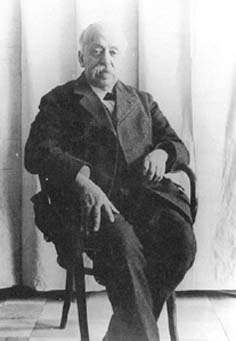Ernesto Schiaparelli
Ernesto Schiaparelli (Italian pronunciation: [erˈnɛsto skjapaˈrɛlli]; July 12, 1856 – February 14, 1928) was an Italian Egyptologist, born in Occhieppo Inferiore (Biella), who found Queen Nefertari's tomb in Deir el-Medina in the Valley of the Queens (1904) and excavated the TT8 tomb of the royal architect Kha (1906), found intact and displayed in toto in Turin. He was appointed director of the Egyptian Museum in Florence, where he professionally reorganized the collection in new quarters in 1880, then at the peak of his career was made director of the Museo Egizio di Torino, which became with him and his many seasons of excavating, the second biggest Egyptian museum in the world. He was the author of famous scholarly works and a Senator of the Kingdom of Italy. At the same time, he was deeply involved, from his first stay with Franciscan missionaries at Luxor in 1884, with relieving the poverty he saw among the missionaries of Upper Egypt, for whom he founded the Association to Succour Italian Missionaries (ANSMI), which expanded its work to care for Italian emigrants throughout the Near East.

Schiaparelli was from a distinguished family of scholars. His father Luigi Schiaparelli taught history at the University of Turin. Giovanni Virginio Schiaparelli, the famous astronomer, Celestino, the Arabist, Cesare, the pioneer of photography, Carlo Felice, the agronomist, Giovanni Battista, a pioneer of industrial chemistry and Elsa Schiaparelli, one of the most prominent figures in fashion between the two World Wars were among his kin.
Between 1903 and 1920 Schiaparelli undertook twelve archaeological campaigns, opening sites in Heliopolis, the cemeteries of Giza, Hermopolis, Assiut, Qaw el-Kebir, Gebelein and Aswan (the tomb of Harkhuf).
In 1902 permission to excavate the Western cemetery in Giza was granted by Gaston Maspero, director of the Egyptian Antiquities Service. The area was divided into three sections, and chosen by lot. The southern section was given to the Italians under Ernesto Schiaparelli, the northern strip to the Germans under Ludwig Borchardt, and the middle section to Andrew Reisner.[1]
| Preceded by Ariodante Fabretti |
Director of the Museo Egizio 1894–1928 |
Succeeded by Giulio Farina |
Main publications
- Del sentimento religioso degli Egiziani (1877)
- Il Libro del Funerali degli antichi Egiziani, 3 vols. (1881-1890) On the Egyptian Book of the Dead.
- Les Hypogées de Thebes (1889)
References
- Markowitz, Yvonne J., Joyce L. Haynes, and Rita E. Freed. Egypt in the Age of the Pyramids: Highlights from the Harvard University-Museum of Fine Arts, Boston Expedition. Boston, Mass: MFA Publications, 2002. Page 33.
External links
- Schiaparelli (in Italian)
Gallery
.jpg) Kha's tomb was discovered intact by Ernesto Schiaparelli in 1906.
Kha's tomb was discovered intact by Ernesto Schiaparelli in 1906.